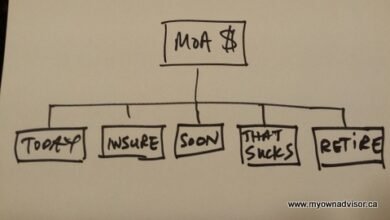من الماضي إلى الحاضر: كيف أدير حساب LIRA الخاص بي بذكاء؟

It looks like you’re sharing a detailed overview of your investment journey with your Locked-In Retirement Account (LIRA) and how you’ve managed it over the years. Here’s a summary of the key points from your post:
- Understanding LIRA: A LIRA is essentially a locked-in RRSP that holds pension funds when you leave an employer. The funds are “locked-in,” meaning they cannot be accessed until retirement, which helps in preserving savings for future use.
- Investment Strategy Evolution:
– In 2010, you were focused on individual stocks like Enbridge and Bank of Montreal, as well as some bond ETFs for stability.
– By 2015, you shifted towards more equity diversification by investing in tech through the QQQ ETF instead of holding individual stocks.
– In 2018, you considered consolidating your investments into fewer ETFs for simplicity but ended up diversifying further while maintaining some holdings in QQQ.
- Current Management (2024): You have recently invested in CBIL ETF to secure a yield while planning to convert your LIRA into a Life Income Fund (LIF) around age 55. This strategy allows you to generate income without selling growth-oriented assets immediately.
- Future Plans: As you approach age 55, you’ll have options to unlock part of your LIRA and potentially transfer assets into an RRSP when converting to a LIF. You plan to keep updating on decisions regarding cash flow and asset mix as part of broader retirement income planning.
- Reflections on Investment Choices: You reflect on whether sticking solely with certain high-performing investments (like QQQ) might have yielded better results but acknowledge that every investment journey has its lessons.
- Engagement with Readers: You invite feedback from readers who may have similar experiences or different strategies regarding their own LIRAs or retirement accounts.
Your approach emphasizes long-term thinking and adaptability in managing retirement accounts while considering both growth potential and income generation strategies as retirement approaches. If readers are interested in discussing their own experiences or seeking advice based on yours, it could foster valuable conversations about personal finance management during this critical phase of life!It sounds like you have a solid plan in place for managing your LIRA and transitioning to a LIF. Your approach of using low-cost ETFs, such as HEQT and QQQ, while also incorporating cash-alternative ETFs like CBIL, seems well thought out. This strategy allows you to maintain growth potential while ensuring liquidity for withdrawals when needed.
As you near the age of 55 and consider unlocking your LIRA assets, it’s great that you’re thinking ahead about how this will impact your overall cash flow and asset mix. The ability to move 50% of your LIRA assets into an RRSP can provide additional flexibility in managing retirement income.
Your historical performance with the LIRA—from $7,000 in 2001 to over $60,000 today—demonstrates effective long-term investing without adding new money. It’s understandable to reflect on whether different choices could have yielded better results (like staying fully invested in QQQ), but it’s important to recognize that diversification can help mitigate risks.
In terms of what others might do differently with their own LIRAs or transitions to a LIF, it often comes down to individual risk tolerance and financial goals. Some may prioritize higher growth investments while others might focus on stability and income generation.
it seems you’re on the right track! Staying disciplined with your investment strategy and avoiding unnecessary tinkering is wise as you work towards generating meaningful cash flow from your portfolio. If readers have similar experiences or insights regarding their own investment choices or strategies for managing retirement accounts like a LIRA or LIF, sharing those could foster valuable discussions within the community.
Happy investing!It looks like you’ve shared a detailed account of your investment journey with your Locked-In Retirement Account (LIRA) over the years, highlighting key decisions and changes in your portfolio. Here’s a summary of the main points:
Overview of LIRA Management
- Unlocking Options: In Ontario, you can unlock your LIRA at age 55 and convert it into a Life Income Fund (LIF).
- Investment Strategy Evolution:
- 2010: Initially focused on Canadian and U.S. stocks, including Enbridge (ENB), Bank of Montreal (BMO), and Coca-Cola (KO). Also invested in low-cost bond ETFs like iShares XBB for stability.
– 2015: Shifted towards more equity diversification by selling KO stock to invest in the tech-focused ETF QQQ.
- 2018: Considered moving everything into QQQ for lazy indexing but opted to maintain some diversification by holding both QQQ and other assets.
- Current Portfolio Composition (2024):
– Over 75% in HEQT (a growth equity fund).
– Some investments in CBIL ETF for yield (~4%+) without needing to sell equities.
– Continued holding some QQQ.
- Future Plans:
– As you approach age 55, you plan to ”unlock” part of your LIRA, potentially converting half into an RRSP while activating the LIF.
– The goal is to generate meaningful cash flow from this retirement account as part of a broader financial independence strategy.
- Performance Reflection:
– Your initial investment has grown significantly from about $7,000 in January 2001 to over $60,000 today without additional contributions.
– You anticipate that with continued growth, it could exceed $75,000 by the time you convert it into a LIF.
Key Takeaways
- Your investment choices reflect an evolving strategy aimed at balancing growth with risk management through diversification across sectors and asset classes.
- The decision-making process around unlocking funds indicates careful planning for future income needs during retirement.
- Maintaining focus on low-cost ETFs aligns well with long-term investing principles aimed at minimizing fees while maximizing returns.
Questions for Reflection
- What lessons have you learned from past investment decisions that might influence future choices?
- How do market conditions affect your confidence in maintaining or adjusting your current asset mix?
Your journey illustrates how adapting strategies based on market trends and personal circumstances can lead to successful long-term investing outcomes!




